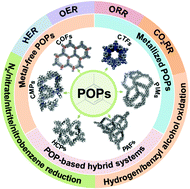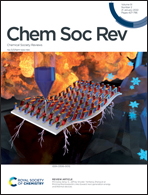Porous organic polymers for electrocatalysis†
Abstract
Porous organic polymers (POPs) composed of organic building units linked via covalent bonds are a class of lightweight porous network materials with high surface areas, tuneable pores, and designable components and structures. Owing to their well-preserved characteristics in terms of structure and composition, POPs applied as electrocatalysts have shown promising activity and achieved considerable advances in numerous electrocatalytic reactions, including the hydrogen evolution reaction, oxygen evolution reaction, oxygen reduction reaction, CO2 reduction reaction, N2 reduction reaction, nitrate/nitrite reduction reaction, nitrobenzene reduction reaction, hydrogen oxidation reaction, and benzyl alcohol oxidation reaction. Herein, we present a systematic overview of recent advances in the applications of POPs in these electrocatalytic reactions. The synthesis strategies, specific active sites, and catalytic mechanisms of POPs are summarized in this review. The fundamental principles of some electrocatalytic reactions are also concluded. We further discuss the current challenges of and perspectives on POPs for electrocatalytic applications. Meanwhile, the possible future directions are highlighted to afford guidelines for the development of efficient POP electrocatalysts.

- This article is part of the themed collection: Future Applications and Techniques using Porous Organic Polymers


 Please wait while we load your content...
Please wait while we load your content...